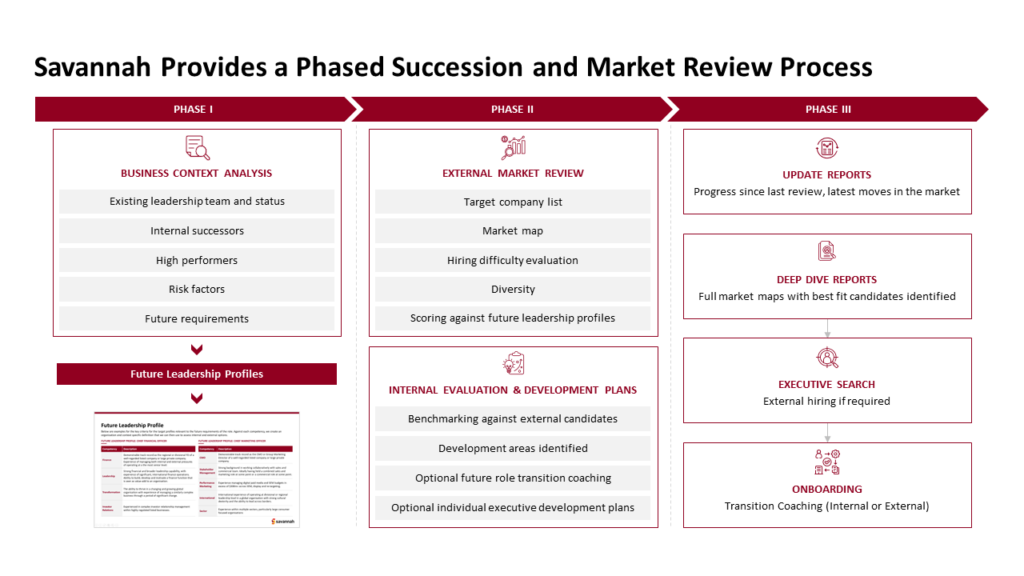In the 2023 Gartner Board of Directors Talent Survey, 79% of board members rated executive succession as ‘very’ or ‘extremely’ important to their business.
Savannah Partner Ali Palmer and Clancy Murphy, former FTSE 250 CHRO and senior advisor for Savannah Group, sat down to discuss the actions leaders can take to ensure seamless, successful leadership transitions. Four priorities emerged.
Ali: What are organisations, in general, doing well when it comes to succession planning?
Clancy: There is an increasing focus on succession and the recent Gartner report just confirms what we are seeing on the ground with our clients: boards want a clear view of who will be key in the business in the future. This senior level sponsorship is important as it ensures that succession is seen as a priority. We are seeing more demand for help in supporting internal pipelines of talent. The market, particularly for some of the more niche roles in technology and data, remains extremely competitive and so being able to develop these skills in house creates a level of organisational resilience which is crucial to future success.
Ali: And where is there room for improvement?
Clancy: Having said that there is increasing focus on building skills internally to support future succession, there is always room for improvement. One area where organisations can get things wrong is by making succession a ‘closed door exercise’. Succession planning should not be a dark art practiced in secret. It should be a fundamental part of the talent management strategy where there is clarity around what the organisation will require from key roles in the future, and opportunities for progression and learning to support this. Increased levels of transparency support a learning culture and this has a wider impact on retention and engagement – so are a real win-win. Additionally, there can be a temptation to focus only on those employees deemed to be high potential. This increases the sense that succession planning only includes a select group and is not inclusive. Development and progression opportunities need to be discussed at all levels in the organisation, and regularly, to ensure all potential is being engaged and leveraged.
Ali: So what should organisations prioritise if they are to improve their executive succession planning?
Clancy: There are four key elements of succession planning which make a real difference to the strength of succession pipelines – and ultimately to whether the planning done around succession delivers results.
- Identify high-potential candidates early and work with them closely.
It is key that what makes a high-potential individual is understood across the organisation. This understanding will then support the identification of the broadest, most diverse group of high-potential individuals from different parts of the organisation. Once identified, a plan for development and engagement needs to be put in place so that these individuals are motivated and engaged with the future of the business – meaning that investment in their development leads to returns for the business. Regular feedback, mentorship programmes, and tailored development plans are essential components in nurturing these individuals, ensuring they are prepared for future leadership roles and can contribute effectively to the organisation’s strategic goals.
2. Understand how your potential internal successors compare to the external candidate market.
Internally, selected high-potential candidates are known entities. They have existing relationships they can lean on and know how to ‘get things done’. On the other hand, they may require more transition coaching to successfully make the step-up to their role. Conversely, the external candidate pool brings a diverse range of experiences, skills, and perspectives and can inject fresh ideas and innovation. The start point should always be where the organisation and/or function needs to get to in the next 12, 18, 24 months. By thoroughly analysing both internal and external pipelines, you can make informed decisions on whether to promote from within or recruit externally. Being prepared early gives organisations flexibility in approach whether that is implementing development programmes or speeding up external candidate engagement and hiring if necessary. We have seen this approach have a positive impact on internal candidate acceptance, contributing to seamless transitions.

3. Create clear progression pathways with transparent expectations.
The better the path to the future is understood, the more likely it is that colleagues will engage with it. These pathways don’t need to be straight lines – they could require spending time in roles outside the current business area, which might mean a sideways move for a period to gain broader business exposure. Whatever is required, this needs to be clear, well-understood, and communicated. Transparent expectations help employees see their potential growth within the company, fostering a sense of purpose and direction. Regular career discussions, well-defined milestones, and visible success stories can motivate employees to follow these pathways and invest in their development, ultimately enhancing organisational performance.
4. Develop a culture of continuous learning and development.
The most senior leaders today started their careers at a different point and have arrived at where they are through learning and development opportunities which they took advantage of. Learning opportunities are not just in the classroom – a culture of development means that there are many ways to learn new skills and develop as a leader through working with different colleagues and experiencing different projects. Encouraging a mindset of lifelong learning ensures that employees remain adaptable and innovative. Offering a mix of formal training, on-the-job experiences, and mentoring relationships helps employees continuously grow and adapt to new challenges. This culture not only enhances individual capabilities but also drives organisational success by fostering a dynamic and resilient workforce.
These four things, when done well, lead to much stronger succession outcomes in terms of developing strong internal pipeline and retention of high-potentials, broadening skills and competencies internally, and ensuring that critical appointment decisions are made in the full knowledge of the comparative skills outside the organisation. Ultimately, this approach leads to seamless, successful leadership transitions.
For more information about how we can help with your succession planning click here




